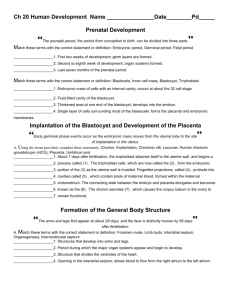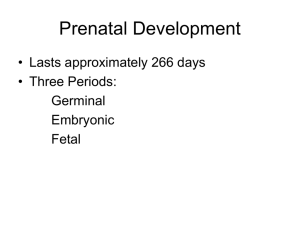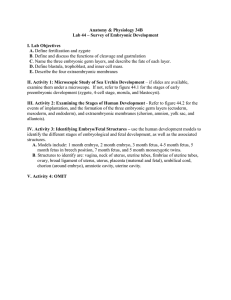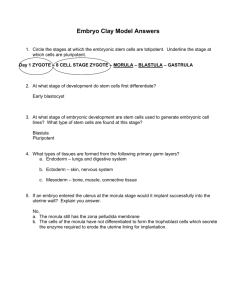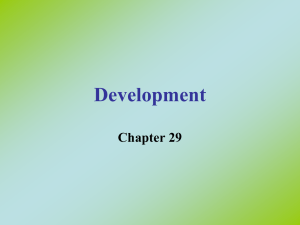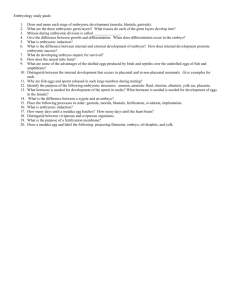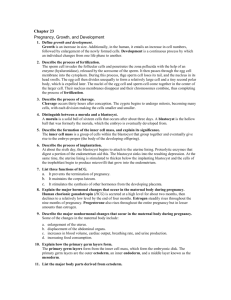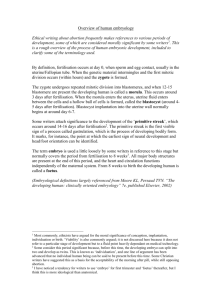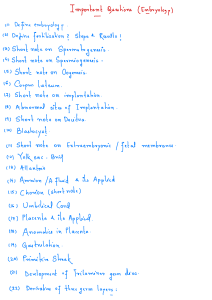Embryology Survey of Embryonic Development: 3 basic activities are involved in... viable offspring:
advertisement
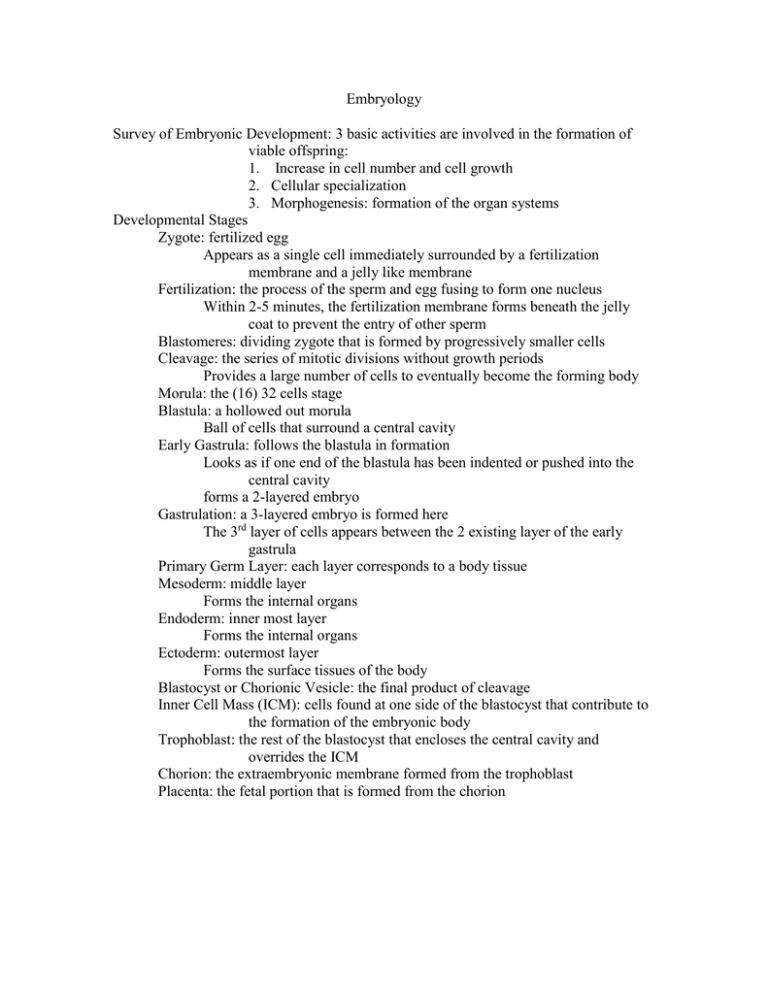
Embryology Survey of Embryonic Development: 3 basic activities are involved in the formation of viable offspring: 1. Increase in cell number and cell growth 2. Cellular specialization 3. Morphogenesis: formation of the organ systems Developmental Stages Zygote: fertilized egg Appears as a single cell immediately surrounded by a fertilization membrane and a jelly like membrane Fertilization: the process of the sperm and egg fusing to form one nucleus Within 2-5 minutes, the fertilization membrane forms beneath the jelly coat to prevent the entry of other sperm Blastomeres: dividing zygote that is formed by progressively smaller cells Cleavage: the series of mitotic divisions without growth periods Provides a large number of cells to eventually become the forming body Morula: the (16) 32 cells stage Blastula: a hollowed out morula Ball of cells that surround a central cavity Early Gastrula: follows the blastula in formation Looks as if one end of the blastula has been indented or pushed into the central cavity forms a 2-layered embryo Gastrulation: a 3-layered embryo is formed here The 3rd layer of cells appears between the 2 existing layer of the early gastrula Primary Germ Layer: each layer corresponds to a body tissue Mesoderm: middle layer Forms the internal organs Endoderm: inner most layer Forms the internal organs Ectoderm: outermost layer Forms the surface tissues of the body Blastocyst or Chorionic Vesicle: the final product of cleavage Inner Cell Mass (ICM): cells found at one side of the blastocyst that contribute to the formation of the embryonic body Trophoblast: the rest of the blastocyst that encloses the central cavity and overrides the ICM Chorion: the extraembryonic membrane formed from the trophoblast Placenta: the fetal portion that is formed from the chorion The blastocysts begins to implant at day 7 The developing embryo is floating free in the uterine cavity Around day 7-8 it adheres to the wall of the uterine cavity over the ICM area and implantation begins The trophoblast secretes enzymes that erode the uterine mucosa at the point of attachment in order to reach vascular supply By the 14th day, implantation is complete and the uterine mucosa has grown over the burrowed embryo Decidua Basalis: the portion of the uterine wall beneath the ICM that is destined to take part in placenta formation Decidua Capsularis: the surrounding rest of the blastocyst Gastrula Stage: embryonic development has progressed to this by the time that implantation has occurred The 3 primary germ layers are present and are beginning to differentiate Within 6 weeks, nearly all the body organ systems are formed by the germ layers The ectoderm will give rise to the epidermis of the skin and nervous system The endoderm forms the mucosa of the digestive system and respiratory system and associated glands The mesoderm forms virtually everything else lying between the two (skeleton, walls of digestive organs, urinary system, skeletal muscles, circulatory system and others) All ground work is completed by week 8 Fetus: the 9th week of development The major activities are growth and tissue and organ specialization Chorionic Villi: tissue layer that has large villi Attached to the uterine wall Placenta: the composite of uterine tissue and chorionic villi Amnion: encases the young embryonic body in a fluid filled chamber that protects the embryo against trauma and temperature extremes Also prevents adhesions during rapid embryonic growth Yolk Sac: no real function in the human Meant to pass nutrients to the embryo, but in humans the placenta is used Very little to begin within the human Allantois: protrudes from the posterior end of the yolk sac Is redundant in humans because of the placenta Is a repository for embryonic waste in other organisms Is the structural basis on which the mesoderm migrates to form the umbilical cord Umbilical Cord: attaches the embryo to the placenta
